Tower Semiconductor Bundle
How Does Tower Semiconductor Conquer the Semiconductor Market?
Tower Semiconductor's journey is a compelling case study in strategic market positioning and sales execution within the competitive semiconductor industry. From its origins in Israel to its global footprint, the company has consistently adapted its sales and marketing strategies. This exploration will uncover the secrets behind Tower Semiconductor's success, examining its evolution and innovative approaches.
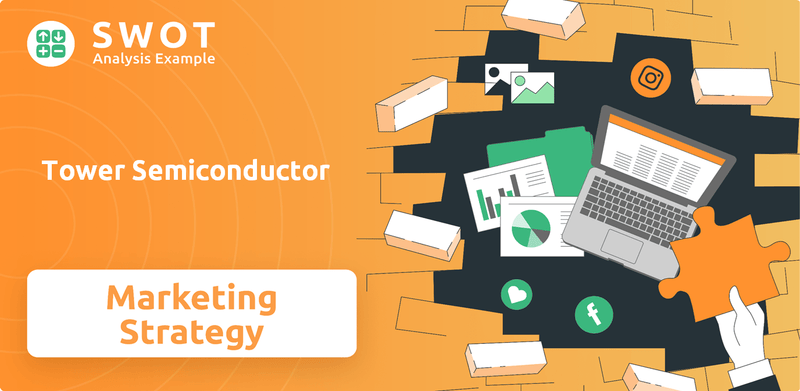
This deep dive into Tower Semiconductor's business model will dissect its sales channels, marketing tactics, and brand positioning within the analog semiconductor ecosystem. We'll analyze key campaigns that have driven growth, including detailed insights into its Tower Semiconductor SWOT Analysis. Understanding the company's approach to customer relationship management and digital marketing strategies is crucial for investors and industry analysts seeking to understand its competitive advantages and future outlook, including strategic partnerships and investment opportunities.
How Does Tower Semiconductor Reach Its Customers?
The sales strategy of Tower Semiconductor centers on direct engagement, primarily targeting fabless semiconductor companies and integrated device manufacturers (IDMs). This approach fosters long-term partnerships, offering customized process technologies and design services. The company's global sales network is crucial for supporting its diverse customer base.
Tower Semiconductor's sales channels are designed to provide multi-fab sourcing and expanded capacity. Their manufacturing facilities are strategically located across the globe, including Israel, the U.S., and Japan. Furthermore, the company has expanded its 300mm wafer capacity through partnerships, such as the shared facility with STMicroelectronics in Italy and access to Intel's New Mexico factory.
These strategic moves, including a $350 million investment announced in Q3 2024 to boost SiPho and SiGe capacity, are designed to meet increasing market demand and enhance production capabilities. These partnerships and investments contribute significantly to growth and market share by providing capacity assurance and operational flexibility to their customers. For more insight into the company's origins, consider reading the Brief History of Tower Semiconductor.
Tower Semiconductor's primary sales strategy relies on a direct sales model. This involves direct interaction with customers. The company focuses on building long-term relationships with clients.
The company supports its global customer base with sales offices strategically located worldwide. These offices are in the US, Israel, China, Japan, Korea, and Taiwan. This extensive network ensures close proximity and support for customers.
Tower Semiconductor has strategically expanded its manufacturing capacity. This includes partnerships and investments in 300mm wafer production. These expansions are crucial for meeting increasing market demand.
The company leverages strategic partnerships to enhance its production capabilities. Collaborations with companies like STMicroelectronics and access to Intel's facilities are key. These partnerships provide capacity assurance and operational flexibility.
Tower Semiconductor's sales and marketing strategies focus on direct customer engagement and strategic capacity expansion to maintain a strong position in the semiconductor industry. The company's approach includes direct sales, a global sales network, and strategic partnerships.
- Direct Sales: Emphasizes direct interaction with customers, especially fabless semiconductor companies and IDMs.
- Global Presence: Operates sales offices in key regions to support a global customer base.
- Capacity Expansion: Invests in expanding manufacturing capabilities, including 300mm wafer production.
- Strategic Partnerships: Collaborates with other companies to increase production capacity and market reach.
Tower Semiconductor SWOT Analysis
- Complete SWOT Breakdown
- Fully Customizable
- Editable in Excel & Word
- Professional Formatting
- Investor-Ready Format
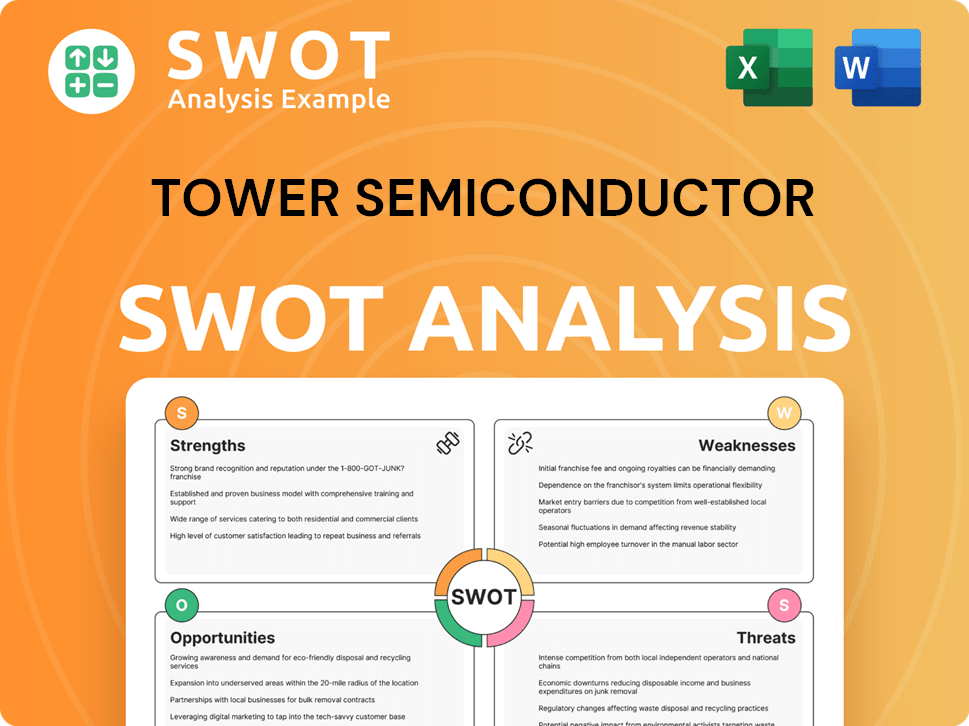
What Marketing Tactics Does Tower Semiconductor Use?
The marketing tactics of Tower Semiconductor are primarily centered around a business-to-business (B2B) approach. This strategy emphasizes technical expertise, collaborative development, and the cultivation of long-term partnerships within the semiconductor industry. Their focus is on providing comprehensive solutions for customers, supporting their design processes, and ensuring high-quality manufacturing.
Their approach is tailored to the specific needs of their clients in various sectors. Tower Semiconductor's marketing efforts are designed to highlight its capabilities in specialized areas like silicon photonics and silicon germanium, which are crucial for technologies such as AI and 5G infrastructure. They also focus on promoting their advanced production platforms and breakthrough solutions.
Tower Semiconductor leverages its world-class design enablement platform to facilitate quick and accurate design cycles for its customers. They are actively involved in continuous development of advanced production platforms and breakthrough solutions for diverse analog electronics markets. This comprehensive approach is key to their Tower Semiconductor sales strategy.
Tower Semiconductor maintains a strong online presence through its corporate website. This site serves as a central hub for investor relations, news announcements, and detailed information about their technology offerings. They use digital platforms to communicate with stakeholders.
The company actively participates in industry conferences and events. An example is their participation in the Applied Power Electronics Conference (APEC) in March 2025, where they showcased their cutting-edge power management technology. They use these events to network and demonstrate their technological capabilities.
Tower Semiconductor's marketing strategy is customer-centric, focusing on providing tailored analog solutions. This approach is evident in their differentiated products. They aim to meet specific client needs in a variety of industries.
They use data-driven marketing and customer segmentation to offer tailored analog solutions. This approach helps them create differentiated products. This enables them to target specific customer needs effectively.
The company's marketing efforts highlight expertise in high-growth areas like silicon photonics and silicon germanium. These areas are critical for AI and 5G infrastructure. This focus aligns with current market demands.
Providing design support and complementary technical services acts as a direct marketing and lead generation tool. This approach helps them build relationships with potential customers. This strategy supports their overall Tower Semiconductor marketing strategy.
The company's sales and marketing efforts are designed to support its overall business model. For a deeper dive into their growth strategies, consider reading the Growth Strategy of Tower Semiconductor. This approach is crucial for navigating the competitive landscape of the semiconductor industry, ensuring sustainable growth and maintaining a strong market position. The company's focus on innovation and customer collaboration is key to their success. Their ability to adapt to market changes and technological advancements is also very important for their future outlook.
Tower Semiconductor's marketing tactics are centered on B2B engagements, emphasizing technical expertise and long-term partnerships. They provide design support and participate in industry events. Their strategies are tailored to meet specific customer needs.
- B2B Focus: Targeting other businesses with specialized solutions.
- Technical Expertise: Highlighting their advanced manufacturing capabilities.
- Collaborative Development: Working closely with clients on product design.
- Industry Events: Participating in conferences to showcase technology.
- Digital Presence: Maintaining a strong online presence for information.
Tower Semiconductor PESTLE Analysis
- Covers All 6 PESTLE Categories
- No Research Needed – Save Hours of Work
- Built by Experts, Trusted by Consultants
- Instant Download, Ready to Use
- 100% Editable, Fully Customizable
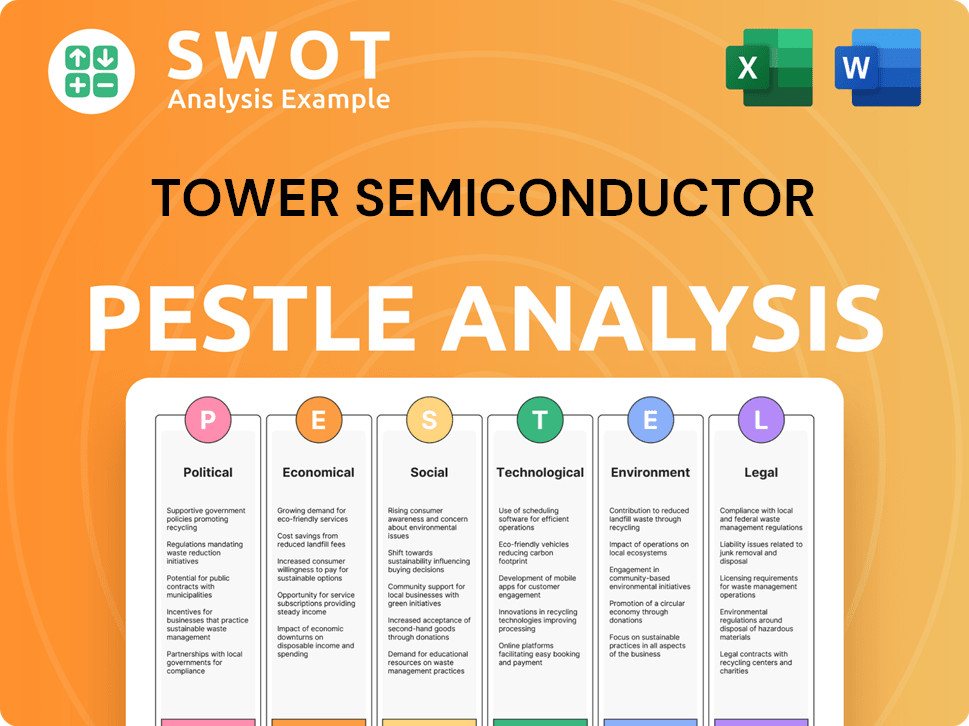
How Is Tower Semiconductor Positioned in the Market?
The brand positioning of Tower Semiconductor centers on its identity as a leading independent specialty foundry. Their core strategy involves providing high-value analog semiconductor solutions, emphasizing differentiated products through customizable process technologies and design services. This approach allows them to cater specifically to the needs of fabless companies and integrated device manufacturers (IDMs), creating a strong presence in the semiconductor industry.
Tower Semiconductor differentiates itself by focusing on specialized analog process technologies like SiGe, RF SOI, and BCD, rather than competing directly on the most advanced digital nodes. This strategic specialization creates high barriers to entry, allowing them to lead the analog ecosystem with innovative technological and manufacturing solutions. Their focus is on delivering high-quality and effective solutions to their customers.
The company's brand message emphasizes trust, strategic customer roadmap alignment, and an innovative mindset to drive value creation. They aim to provide strong competitive advantages in growing markets such as automotive, industrial, and consumer electronics. A key aspect of their strategy is maintaining brand consistency through a focus on quality, efficiency, and effectiveness across all operations. For a broader understanding, you can explore the Competitors Landscape of Tower Semiconductor.
Tower Semiconductor's sales and marketing strategy prioritizes customer needs through customized solutions. This approach enables the company to build strong, long-term relationships with its clients. Their focus on specialized analog process technologies allows them to address specific market needs effectively.
The company's competitive advantage lies in its specialization in analog technologies, creating high barriers to entry. This focus allows them to offer unique solutions that are not easily replicated by larger competitors. This positions them well within the semiconductor industry analysis.
Tower Semiconductor targets growing markets such as automotive, industrial, and consumer electronics. Their product portfolio overview is designed to meet the specific demands of these sectors. This strategic focus supports their revenue growth strategies.
Innovation is a core element of Tower Semiconductor's brand. They continuously develop advanced production platforms and invest in cutting-edge technologies. This commitment to innovation helps them maintain a strong market position and address future challenges.
Tower Semiconductor employs several key strategies to maintain its market position and drive growth. These include strategic partnerships, customer relationship management, and digital marketing strategies. Their approach supports both their sales and marketing strategy.
- Focus on specialized analog technologies.
- Build strong customer relationships through tailored solutions.
- Target high-growth markets.
- Continuous innovation in production and technology.
Tower Semiconductor Business Model Canvas
- Complete 9-Block Business Model Canvas
- Effortlessly Communicate Your Business Strategy
- Investor-Ready BMC Format
- 100% Editable and Customizable
- Clear and Structured Layout
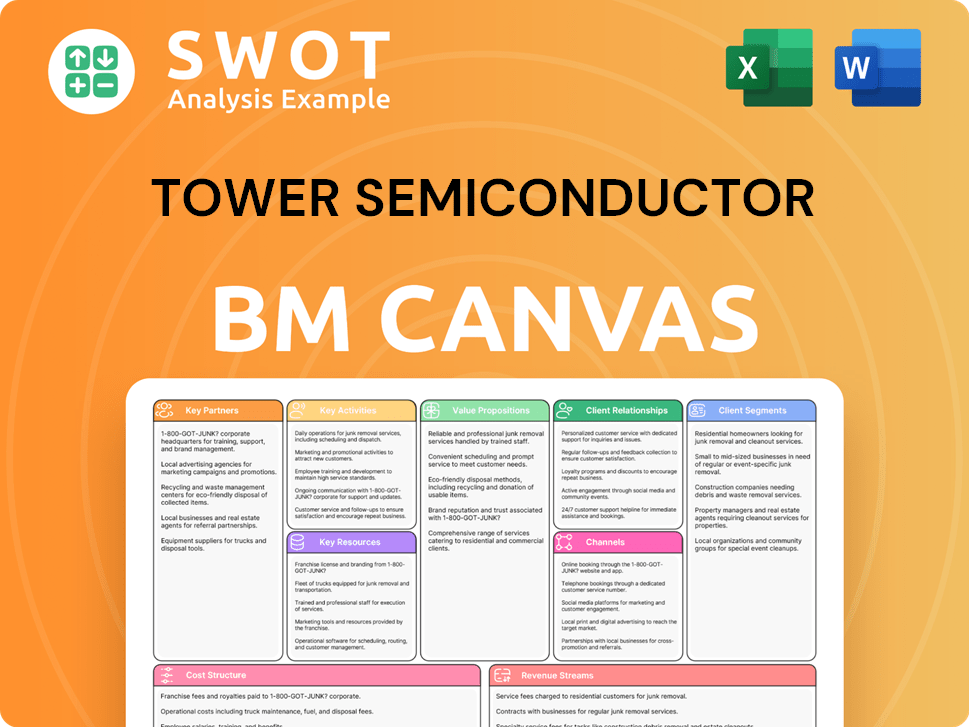
What Are Tower Semiconductor’s Most Notable Campaigns?
The sales and marketing strategy of Tower Semiconductor, a B2B specialty foundry, is primarily defined by its strategic initiatives and partnerships, rather than traditional consumer-facing marketing campaigns. These initiatives function as key 'campaigns,' communicating its market objectives and driving growth within the semiconductor industry. The company's focus is on expanding production capacity and strengthening its position in advanced technologies.
One of the most significant 'campaigns' involves substantial investment in equipment and capital expenditures. This includes a $500 million allocation for collaboration with STMicroelectronics in Italy and a $300 million investment in Intel's New Mexico fab. These investments are aimed at meeting the increasing demand in high-growth AI infrastructure markets. These strategic moves effectively communicate Tower Semiconductor's commitment to growth, innovation, and industry leadership.
Another crucial 'campaign' involved a proposed $10 billion semiconductor project with India's Adani Group, approved in September 2024. Despite withdrawing from the project later, this engagement showcased their intent to diversify manufacturing geographically and meet global market demand. Tower Semiconductor's revenue for the full year 2024 was $1.44 billion, with a net profit of $208 million, and they forecast a revenue growth of around 10% year-over-year for the first quarter of 2025.
Tower Semiconductor is making significant investments to boost production capacity. These investments, including a $500 million allocation for its collaboration with STMicroelectronics and a $300 million investment in Intel's fab, are key to meeting growing market demands.
The company's investments are primarily focused on advanced technologies like silicon photonics and silicon germanium. These technologies are crucial for high-speed data transfers and power saving, positioning Tower Semiconductor for future growth.
The proposed project with the Adani Group in India highlighted Tower Semiconductor's interest in diversifying its manufacturing footprint. Although the project was withdrawn, the initial plan demonstrated their commitment to global expansion.
In 2024, Tower Semiconductor reported revenues of $1.44 billion and a net profit of $208 million. The company anticipates around a 10% year-over-year revenue increase for the first quarter of 2025, indicating strong financial health.
The primary objectives of Tower Semiconductor's sales and marketing strategy revolve around capacity expansion, technological advancement, and global market diversification. These goals are supported by significant investments and strategic partnerships.
- Increase production capacity to meet growing demand in key markets.
- Strengthen competitive advantage in advanced technologies like silicon photonics and silicon germanium.
- Explore opportunities for global expansion to diversify manufacturing and reach new customers.
- Maintain strong financial performance and achieve sustainable revenue growth.
Tower Semiconductor Porter's Five Forces Analysis
- Covers All 5 Competitive Forces in Detail
- Structured for Consultants, Students, and Founders
- 100% Editable in Microsoft Word & Excel
- Instant Digital Download – Use Immediately
- Compatible with Mac & PC – Fully Unlocked
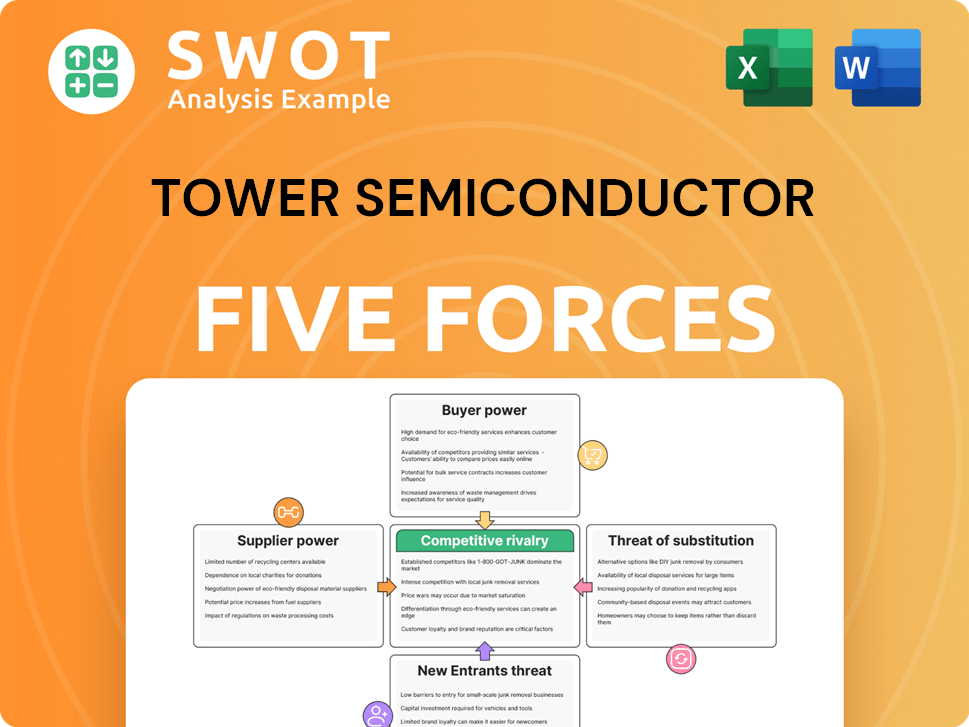
Related Blogs
- What are Mission Vision & Core Values of Tower Semiconductor Company?
- What is Competitive Landscape of Tower Semiconductor Company?
- What is Growth Strategy and Future Prospects of Tower Semiconductor Company?
- How Does Tower Semiconductor Company Work?
- What is Brief History of Tower Semiconductor Company?
- Who Owns Tower Semiconductor Company?
- What is Customer Demographics and Target Market of Tower Semiconductor Company?
Disclaimer
All information, articles, and product details provided on this website are for general informational and educational purposes only. We do not claim any ownership over, nor do we intend to infringe upon, any trademarks, copyrights, logos, brand names, or other intellectual property mentioned or depicted on this site. Such intellectual property remains the property of its respective owners, and any references here are made solely for identification or informational purposes, without implying any affiliation, endorsement, or partnership.
We make no representations or warranties, express or implied, regarding the accuracy, completeness, or suitability of any content or products presented. Nothing on this website should be construed as legal, tax, investment, financial, medical, or other professional advice. In addition, no part of this site—including articles or product references—constitutes a solicitation, recommendation, endorsement, advertisement, or offer to buy or sell any securities, franchises, or other financial instruments, particularly in jurisdictions where such activity would be unlawful.
All content is of a general nature and may not address the specific circumstances of any individual or entity. It is not a substitute for professional advice or services. Any actions you take based on the information provided here are strictly at your own risk. You accept full responsibility for any decisions or outcomes arising from your use of this website and agree to release us from any liability in connection with your use of, or reliance upon, the content or products found herein.